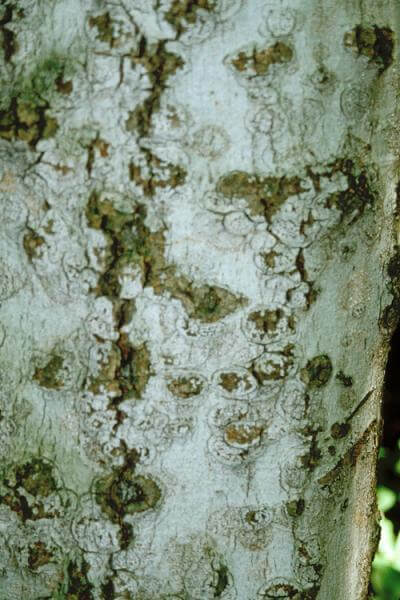
American beech, Fagus grandifolia, is a common component of eastern North American forests. The species is utilized for lumber and pulp, and it periodically produces beech nuts for wildlife. By the 1950s, an exotic insect-disease complex had become established in northeastern beech populations that was causing extensive mortality. Beech bark disease (BBD) is due to the activities of the exotic beech scale insect, Cryptococcus fagisuga, and an associated exotic fungus, Nectria coccinea var. faginata (Mahony et al. 1999) (see also pages on beech leaf disease [BLD] and beech leaf-mining weevil [BLMW]). The scale insect penetrates the bark during feeding, enabling the associated fungus to enter the tree. The tree is girdled from the resulting multiple cankers (Houston and Valentine, 1988).
Beech scale was introduced in the late 1800s into Halifax, Nova Scotia, probably on nursery stock of European beech (Hawbolt, 1944). However, it was not until around 1920 that an outbreak of beech bark disease was recorded (Houston & Valentine, 1988). The disease spread rapidly and was commonplace in Nova Scotia by 1930. In the United States, the first report of beech bark disease was in Massachusetts in 1929 (Houston & Valentine, 1988). By the early 1970s, the disease had spread throughout New England and into eastern Pennsylvania. The scale and associated fungus are easily transported over long distances by animals and humans, which has resulted in isolated outbreaks and establishments in West Virginia (1981), Virginia (1983), and more recently, in the Great Smoky Mountains National Park (Tennessee) far ahead of the advancing front in Pennsylvania (Houston & Valentine, 1988; S. Schlarbaum, pers. comm., 2002).
There is no practical chemical control of the beech scale in natural forests. The scale has several natural predators, but none has been sufficiently effective to stop the spread of beech bark disease. Resistance to beech scale insect attacks has been discovered in some beech trees (Shigo, 1964; Cammermeyer, 1993; Houston & Houston, 2000) and can be integrated into breeding programs to produce beech bark disease-resistant trees for restoration of the species.
USFS scientists and managers developed a conservation priority-setting framework for forest tree species at risk from pest & pathogens and other threats. The Project CAPTURE (Conservation Assessment and Prioritization of Forest Trees Under Risk of Extirpation) uses FIA data and expert opinion to group tree species under threat by non-native pests into vulnerability classes and specify appropriate management and conservation strategies. The scientists prioritized 419 tree species native to the North American continent. The analysis identified 15 taxonomic groups requiring the most immediate conservation intervention because of the tree species’ exposure to an extrinsic threat, their sensitivity to the threat, and their ability to adapt to it. Each of these 15 most vulnerable species, and several additional species, should be the focus of both a comprehensive gene conservation program and a genetic resistance screening and development effort. Exotic beech scale insect is not known to be a threat to any of these 15 most vulnerable species.
Sources
Cammermeyer, J. 1993. Life’s a beech – & then you die. Am. Forests July/August 1993, Pp. 20-21, 46.
Hawbolt, L. S. 1944. History of spread of beech scale, Cryptococcus fagi (Baerensprung), an insect introduced to the Maritime provinces. Acadian Nat. 1: 137-146.
Houston, D. R., and D. B. Houston. 2000. Allozyme genetic diversity among Fagus grandifolia trees resistant or susceptible to beech bark disease in natural populations. Can. J. For. Res. 30: 779-789.
Houston, D. R. and H. T. Valentine. 1988. Beech bark disease: the temporal patterns of cankering in aftermath forests of Maine. Can. J. For. Res. 18: 38-42.
Mahony, E. M., M. G. Milgroom, and W. A. Sinclair. 1999. Origin, genetic diversity and population structure of Nectria coccinea var. faginata in North America. Mycologia 91: 583-592.
Potter, K.M., Escanferla, M.E., Jetton, R.M., Man, G., Crane, B.S., Prioritizing the conservation needs of US tree spp: Evaluating vulnerability to forest insect and disease threats, Global Ecology and Conservation (2019), doi: https://doi.org/10.1016/
Schlarbaum, S. E. September 2002. Department of Forestry, Wildlife, and Fisheries, University of Tennessee, Knoxville, TN., personal communication.
Shigo, A. L. 1964. Organism interactions in the beech bark disease. Phytopathology 54: 263-269.



